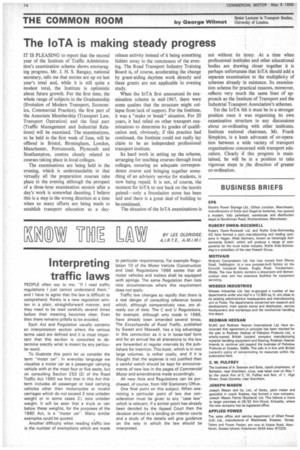Interpreting traffic laws
Page 76

If you've noticed an error in this article please click here to report it so we can fix it.
PEOPLE often say to me: "If I read traffic regulations I just cannot understand them," and I have to agree that the law is difficult to comprehend. Rarely is a new regulation written in a plain, straightforward manner, and they need to be read carefully several times before their meaning becomes clear. Even then there remains pitfalls to be avoided.
Each Act and Regulation usually contains an interpretation section where the various terms used are defined and it is most important that this section is consulted to determine exactly what is meant by any particular word.
To illustrate this point let us consider the term "motor car". in everyday language we visualize a motor car as a passenger carrying vehicle with at the most four or five seats, but on consulting Section 253 121 of the Road Traffic Act 1960 we find that in this Act this term includes all passenger or load carrying vehicles other than motorcycles or invalid carriages which do not exceed 3 tons unladen weight or in some cases 21 tons unladen weight. It will be seen that a truck or van below these weights, for the purposes of the 1960 Act, is a "motor car". Many similar examples could be quoted.
Another-difficulty when reading traffic law is the number of exemptions which are made
to particular requirements. For example Regulation 10 of the Motor Vehicle {Construction and Use) Regulations 1966 states that all motor vehicles and trailers shall be equipped with springs. The same Regulation then lists nine circumstances where this requirement does not apply.
Traffic law changes so rapidly that there is a real danger of consulting reference books which, although comparatively new, are already out of date. The C and U Regulations, for example, although only made in 1966, have already been amended several times. The Encyclopedia of Road Traffic, published by Sweet and Maxwell, has a big advantage in this connection as it is in loose-leaf form and for an annual fee all alterations to the law are forwarded at regular intervals by the publishers for insertion. This book, which is in two large volumes, is rather costly, and if it is thought that the expense is not justified then a careful watch should be kept for announcements of new law in the pages of Commercial Motor and amendments made accordingly.
All new Acts and Regulations can be purchased, of course, from HM Stationery Office.
One final point on this subject. When examining a particular point of law due consideration must be given to any "case law" which is relevant. If a similar point has already been decided by the Appeal Court then the decision arrived at is binding on inferior courts and a study of the details will give guidance on the way in which the law should be interpreted.


















































































































